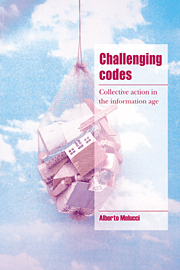Book contents
- Frontmatter
- Contents
- Preface and acknowledgements
- Introduction
- Part I Theory of collective action
- 1 The construction of collective action
- 2 Conflict and change
- 3 Action and meaning
- 4 The process of collective identity
- Part II Contemporary collective action
- Part III The field of collective action
- Part IV Acting collectively
- References
- Index
1 - The construction of collective action
Published online by Cambridge University Press: 23 November 2009
- Frontmatter
- Contents
- Preface and acknowledgements
- Introduction
- Part I Theory of collective action
- 1 The construction of collective action
- 2 Conflict and change
- 3 Action and meaning
- 4 The process of collective identity
- Part II Contemporary collective action
- Part III The field of collective action
- Part IV Acting collectively
- References
- Index
Summary
Traditions
When talking of social movements and collective action, one is usually referring to empirical phenomena with a certain degree of external unity. Movements are often described in terms similar to those used in addressing personalities or personages in tragic theatre, characters with a distinct and coherent role. Yet what in fact is in question are heterogeneous and fragmented phenomena, which internally contain a multitude of differentiated meanings, forms of action, and modes of organization, and which often consume a large part of their energies in the effort to bind such differences together. Movements, characteristically, must devote a considerable share of their resources to the task of managing the complexity and differentiation that constitutes them.
It is, furthermore, customary to refer to movements as the effects of a particular historical situation, or as an outcome of a particular conjuncture (such as an economic crisis or contradictions within the system). In doing so, however, one ignores the motives for, and the meaning and components of, collective action, by assuming that the ways in which such action comes into being and persists over time are irrelevant when compared to the interplay of ‘structural’ variables. These manners of considering social movements as either historical characters or results of structural determinants are not just commonplace notions of everyday discourse; they also stamp many of the current analyses of contemporary collective action.
- Type
- Chapter
- Information
- Challenging CodesCollective Action in the Information Age, pp. 13 - 41Publisher: Cambridge University PressPrint publication year: 1996

